Berto di Giovanni (Roberto di Giovanni di Marco), who was born in Perugia, was first documented in 1488. He held the post of treasurer of the painters' guild of Perugia on a number of occasions (in 1499, 1504, 1514 and 1522).
Berto, who was associated with Perugino in 1494, subsequently became a member of the Workshop of 1496 (see below). He is documented from 1505 as an associate of Raphael, in connection with an altarpiece commissioned by the nuns of Santa Maria di Monteluce (see below), and it seems that he represented Raphael’s interests in Perugia from that time.
Apart from the works described below, Berto’s output in Umbria included a documented altarpiece (1506-7) depicting the Madonna and Child with SS Gregory, John the Baptist, John the Evangelist and Francis from the high altar of San Franceso, Montone is now in the Royal Collection, Hampton Court.
Workshop of 1496
An important document dated 1496 records that a group of artists formed a joint workshop in Perugia and took a year's lease on a workshop near the Porta Eburnea. These artist, some of whom had previously been associated with Perugino, were:
-
✴Eusebio da San Giorgio, who witnessed the contract (1495) commissioning Perugino to paint the San Pietro Altarpiece;
-
✴Berto di Giovanni, who collected a payment on behalf of Perugino in 1494 for the panel of the Pietà that was part of the Decemviri Altarpiece;
-
✴Ludovico di Angelo, who witnessed the final payment to Perugino for the San Pietro Polyptych in 1500; and
-
✴Lattanzio di Giovanni (died 1534), who had previously worked for Bartolomeo Caporali.
It is not known how long the formal association between these artists lasted, by they frequently worked together during the rest of their careers. They do not have seemed to have worked again with Perugino after 1495.
Perugia
Monteluce Altarpiece (1505-25)




Contract of 1505
The “Memoriale di Santa Maria di Monteluce” records that the nuns of Santa Maria di Monteluce decided to commission a new altarpiece for the high altar of their outer (public) church in 1503. They asked the friars at the Convento di Monteripido to recommend “il maestro il migliore” (the finest master) from whom they might commission it, and the friars recommended Raphael. The nuns therefore signed a contract in 1505 with Raphael for an altarpiece of the Coronation of the Virgin that would be delivered within two years.
Berto di Giovanni was also party to this contract, albeit that it referred to Raphael as “Maestro” and specified that he would personally paint the figures. It provided for the cost of transport of the main panel to Perugia, so it was clearly intended that Raphael would paint it somewhere else: the terms of the contract applied in Perugia, Assisi, Gubbio, Rome, Siena, Florence Urbino and Venice. It seems that Berto’s role would relate to:
-
•the co-ordination of the project as a whole; and
-
•the painting of the subsidiary panels in Perugia.
Contract of 1516
No subsequent documents referring to this commission survive until 1516, when the nuns sent Berto di Giovanni to Rome, presumably to press Raphael to begin work, and the contract was duly renegotiated. It now specified only a year before delivery. It also made a specific division between the work expected of the two artists:
-
✴Raphael would paint the main panel in Rome; and
-
✴Berto would paint, in Perugia, the frame and three predella panels, which would depict:
-
•the birth of the Virgin;
-
•the marriage of the Virgin; and
-
•the death of the Virgin.
Berto di Giovanni provided a carpenter in 1518 to make the frame of the altarpiece and a "cassa” (probably a cover that protected it when it was not in use). However, the altarpiece had yet to be started when Raphael died in 1520.
Contract of 1523
In 1523, the nuns agreed a new contract with two of Raphael’s associates in Rome: Giulio Romano and Giovanni Francesco Penni for the painting of the main panel. Finally, on 25th June 1525, the “Memoriale di Santa Maria di Monteluce” records that “the Madonna, our finished painting, was delivered from Rome!”
The frame had been delivered to Berto di Giovanni for painting in 1524. He presumably began the three predella panels at that time. He also agreed to add a fourth predella panel, depicting the Presentation of the Virgin, as well of panels of SS Francis and Clare for the pilasters of the frame. This work was presumably completed in 1525, the date inscribed on predella panel of the birth of the Virgin. The completed altarpiece was probably in place on the high altar of Santa Maria di Monteluce in time for the Feast of the Assumption.
The altarpiece was dismantled in 1750, when the main panel was installed in a new frame on the back wall of the tribune and the other panels were removed to the sacristy. The original frame was presumably destroyed. The surviving panels were never reunited:
-
✴The main panel was confiscated by the French under the Treaty of Tolentino (1797). Antonio Canova recovered it in 1815, when it was secured for the Pinacoteca Vaticana.
-
✴The other panels were taken to Rome in 1812. Two of them (those depicting SS Francis and Clare) were subsequently lost. The four predella panels were returned to the church in 1817 and moved to the Galleria Nazionale in 1863.
Other Works in the Galleria Nazionale
Madonna and Child enthroned with saints (1510)
The Confraternita di Sant’ Agostino commissioned this altarpiece, which is dated by inscription, from Berto di Giovanni and Sinibaldo Ibi for the Oratorio di Sant' Agostino. The altarpiece, which depicts the Madonna and Child enthroned with SS Augustine and Sebastian, was moved to the sacristy, possibly when the oratory was remodelled in the 17th century. The confraternity gave it to the Galleria Nazionale in 1872.
Crucifixion (early 16th century)
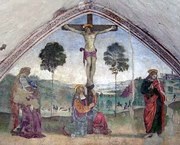
This fresco on what was the altar wall of the hospice of the Oratorio di Sant' Agostino, which was rediscovered in 1991, depicts the Crucifixion with the Virgin and St John the Evangelist and the kneeling St Mary Magdalene. It was initially attributed to the young Raphael, but is now attributed to Berto di Giovanni, Sinibaldo Ibi and/or Lattanzio di Giovanni.
Predella Panel (ca. 1513)

This recently discovered predella panel, which depicts the Pietà with St Mary Magdalene and a female martyr in tondi, is attributed to Berto di Giovanni. It is now in the Galleria Nazionale (Room 27).
The predella seems to have belonged to the altarpiece (1513) that was commissioned from Eusebio da San Giorgio for San Francesco al Prato according to the will of Carlo Berardelli. The main panel of this altarpiece, of SS Antony Abbot, Francis and Bernardino of Siena, is now in the deposit of the gallery.
Sant' Agnese Altarpiece (1517)
This altarpiece, which is dated by inscription, is attributed to Berto di Giovanni. It was first recorded in 1801, when the nuns of Sant’ Agnese gave its main panel to those of Santa Maria di Monteluce in return for the hospitality given to them after their suppression in 1798.
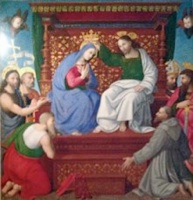
This main panel, which depicts the Coronation of the Virgin with SS Peter, John the Baptist and Jerome on the left and SS Francis, Paul and Herculanus on the right, is based on a drawing by Raphael that is now in the Ashmolean Museum, Oxford. After its transfer to Santa Maria di Monteluce, it was installed on the high altar, where it replaced the panel on the same subject that had been confiscated in 1797. It was listed among works to be sent to the Musei Capitolini, Rome in 1812, but it was subsequently decided that it should remain in the church. It was moved to the Galleria Nazionale in 1863.
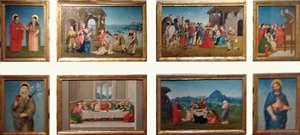
The smaller panels from the altarpiece remained in Sant’ Agnese, although some were moved to the Accademia di Belle Arti in 1810. Eight of them entered the gallery in 1863 and are now displayed together, but separately from the main panel. Their original disposition is unknown, and there might have been others that have been lost:
-
✴Four in the format of vertical rectangles, which probably came from the pilasters of the frame, depict:
-
•SS Cosmas and Damian;
-
•St Bernardino of Siena preaching;
-
•St Clare; and
-
•St Louis of France.
-
✴Four in the format of horizontal rectangles, which probably came from the predella, depict:
-
•the Adoration of the Shepherds;
-
•the Adoration of the Magi;
-
•the Last Supper; and
-
•the Pietà.
St John the Evangelist Altarpiece (ca. 1518)
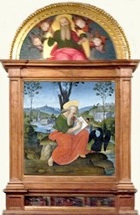
The panels depict:
-
✴God the Father (in the lunette)
-
✴St John the Evangelist writing his gospel on the island of Patmos (in the main panel); and
-
✴scenes from the life of St John the Evangelist (in the predella).
Madonna and Child with saints (ca. 1518)
This altarpiece was recorded in the 18th century in the sacristy of the Convento di Monteripido, and passed to the Galleria Nazionale in 1863. It depicts the Madonna and Child enthroned in a landscape, flanked by the kneeling SS James and Francis. Two flying angels hold a crown above the head of the Madonna.
This panel seems to have been the object of a dispute between Friar Pietro da Castello and Perugino that was settled in 1518. It seems that, although Perugino had received the commission, the panel was actually painted by another artist. Laura Teza (referenced below), who published the relevant document, attributes it to Berto di Giovanni.
Other Works in Perugia
In 1502, Berto di Giovanni, Eusebio da San Giorgio and Nicolò da Cesena received payment for frescoes for the presbytery of the Duomo (later destroyed).
Frescoes (1504)
Berto di Giovanni painted a series of frescoes in Palazzo Alfani (now Palazzo Conestabili). A fragment depicting the Virgin and two saints in a landscape passed into the ownership of the Regione Umbria and is now in Palazzo Donini.
Processional banner (1526)
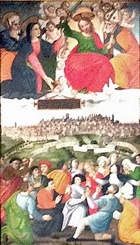
Assisi
Processional banner (early 16th century)
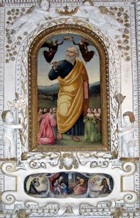
The predella (mid 16th century), which depicts the Holy Family with SS Antony of Padua (on the left) and Bernardino of Siena (on the right), is more securely attributed to Dono Doni.
Redeemer (16th century)
This panel, which is to the right of the entrance to the sacristy of Santa Maria degli Angeli, is attributed to Berto di Giovanni.



